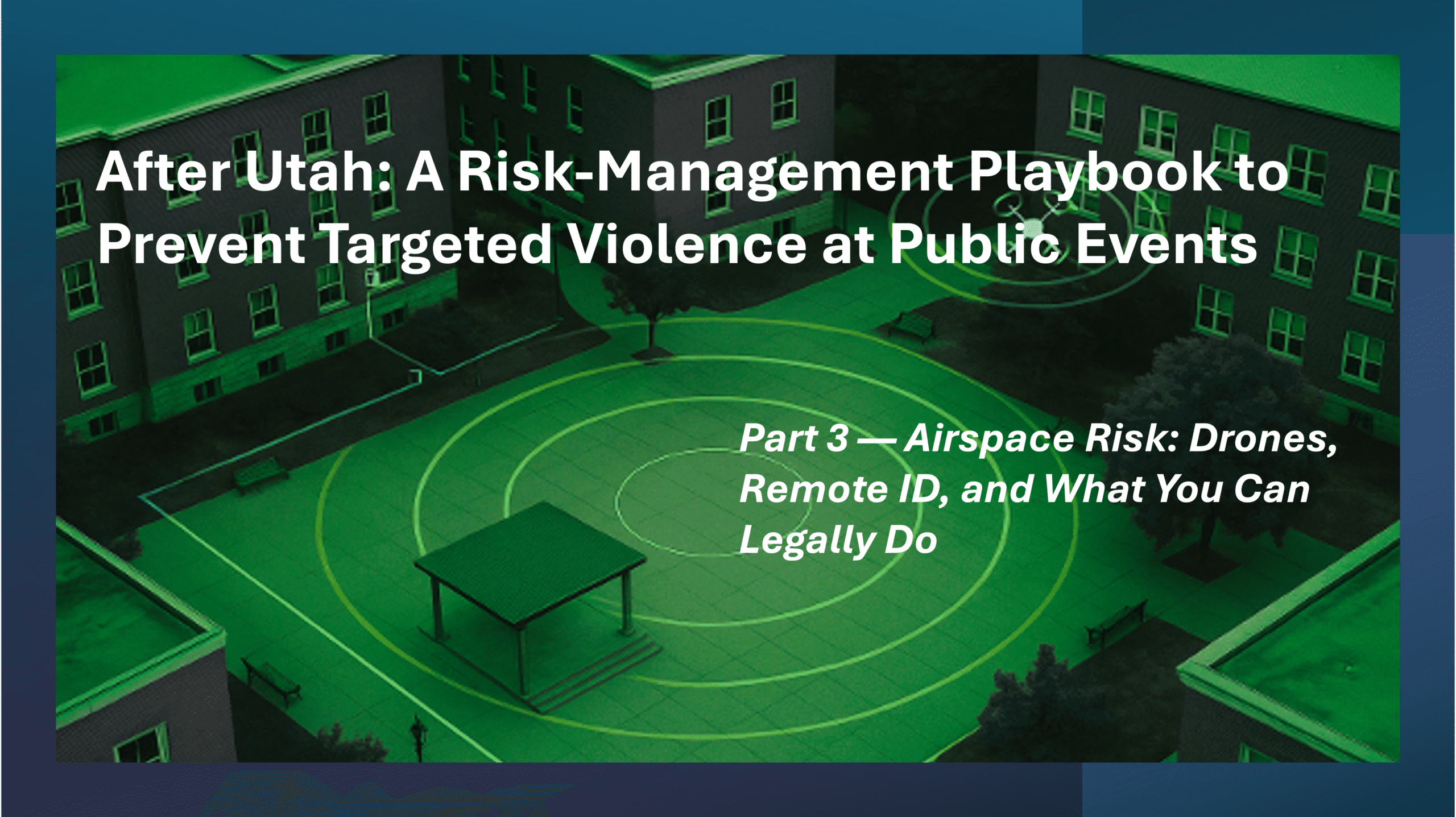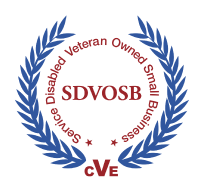Drones, Remote ID, and the Limits of Counter-UAS Authority
Contributed by Jim Brigham, LCG VP of Risk Management, Former Operations Chief, State of Vermont, Office of Safety & Security
Series Context.
This five-part series translates lessons from the September 10 Utah Valley University assassination into practical guidance for campuses, event organizers, and public officials, focusing on threat assessment, drone risk, venue design, digital forensics, and crisis communications. [1]
The Sky is a Perimeter Now.
The Utah attack revealed how open-air events are vulnerable from rooftops and from above. Drones are inexpensive, widely available, and increasingly unconstrained by manufacturer geofencing, which elevates the need for site-specific awareness and monitoring. [1][6] Event teams must also understand the legal boundary. Only select federal agencies, including the Department of Homeland Security and the Department of Justice, hold statutory authority to neutralize or mitigate unmanned aircraft systems under the Preventing Emerging Threats Act of 2018. [2][3] For everyone else, the mission shifts to detection, documentation, and coordination. Remote ID, mandated under 14 CFR Part 89, provides a digital trail that is valuable for both safety decisions and evidentiary use, if you plan ahead to capture and preserve it. [4][5][7]
LCG perspective. Treat the sky like another perimeter. Your role is not interdiction; it is shortening decision time through reliable detection, disciplined logging, and rapid handoff to authorized partners.
Build a Defensible Detection Playbook.
- Know the rules of the road. Train staff on 14 CFR Part 89 Remote ID, what data is broadcast, and what you are permitted to log. Keep a pocket card for what triggers escalation. [4][5][7]
- Map the airspace. Before each event, survey approach vectors, likely launch points, crowd proximities, and roof access. Assign watch responsibility by zone, and pre-plan camera sightlines that can corroborate RF detections.
- Deploy multiple sensors. Combine RF detection, acoustic arrays, optical tracking, and Remote ID capture. Redundancy reduces false positives and builds credibility when you brief law enforcement. [5][7]
- Log with forensics discipline. Treat Remote ID and telemetry like evidence. Timestamp, hash, and preserve logs with chain-of-custody procedures to ensure records can support criminal inquiries, insurance claims, and post-incident reviews. [5][7]
- Coordinate before the event. Establish direct liaison with local police, state authorities, and federal partners to ensure effective coordination and communication. Formalize expectations with written SOPs or MOUs, including who calls whom and what data you will provide. [5]
Risk Drivers in 2025
Two realities heighten urgency for organizers and campus security leaders:
Technical shifts. DJI, the leading commercial manufacturer, no longer enforces strict geofencing, which makes it less likely a drone will be automatically prevented from entering sensitive areas. This puts more pressure on venue-level detection and response. [6]
Governance clarity. Federal law remains clear. Non-federal actors cannot shoot down, jam, or otherwise turn off drones. Your defensible path is robust detection, disciplined logging, and reliable reporting channels to authorized agencies. [2][3][5]
Quick Checklist
1) Treat the airspace as a perimeter.
2) Capture Remote ID and telemetry with validated, defensible methods.
3) Pre-coordinate with agencies that hold counter-UAS authority.
4) Rehearse your handoff protocols; seconds matter.
Final Thought
The Utah tragedy made one thing clear: security is now three-dimensional. The air above your event is as critical as the doors and rooftops around it. While only federal partners can mitigate drone threats, you are responsible for detection, documentation, and disciplined handoff.
If you manage a campus, a rally, or a public gathering, you cannot outsource the sky. Build your detection playbook. Train your people. Treat every Remote ID log as evidence.
Airspace awareness is no longer optional. It is now the mark of credible event security.
References (Endnotes)
[1] Associated Press, “Officials ask for public’s help in finding Charlie Kirk shooter,” Sept. 11, 2025. https://apnews.com/article/4763fec3bb89f18680fda159c413a393
[2] U.S. Department of Homeland Security, Science & Technology, Counter-Unmanned Aircraft Systems Legal Authorities, Fact Sheet, last updated Apr. 10, 2025. https://www.dhs.gov/publication/st-counter-unmanned-aircraft-systems-legal-authorities-fact-sheet
[3] U.S. Department of Justice, Justice Manual § 9-95.000, Unmanned Aircraft Systems (UAS), implementing the Preventing Emerging Threats Act of 2018. https://www.justice.gov/jm/9-95000-unmanned-aircraft-systems-uas
[4] Federal Aviation Administration, 14 CFR Part 89, Remote Identification of Unmanned Aircraft. https://www.ecfr.gov/current/title-14/chapter-I/subchapter-F/part-89
[5] Interagency Security Committee, Protecting Against the Threat of Unmanned Aircraft Systems, Best Practices, Nov. 2020. PDF: https://www.cisa.gov/sites/default/files/publications/Protecting%20Against%20the%20Threat%20of%20Unmanned%20Aircraft%20Systems%20November%202020_508c.pdf ; Overview: https://www.cisa.gov/resources-tools/resources/isc-best-practices-protecting-against-uas-threat
[6] The Verge, “DJI will no longer stop drones from flying over airports, wildfires, and the White House,” Jan. 14, 2025. https://www.theverge.com/2025/1/14/24343928/dji-no-more-geofencing-no-fly-zone
[7] CISA, Public Safety Uncrewed Aircraft System Resource Guide, updated Apr. 2024. PDF: https://www.cisa.gov/sites/default/files/2024-09/public_safety_uas_resource_guide_508.pdf ; Resource page: https://www.cisa.gov/resources-tools/resources/public-safety-unmanned-aircraft-system-resource-guide
*This article is for general information and does not constitute legal advice.*







